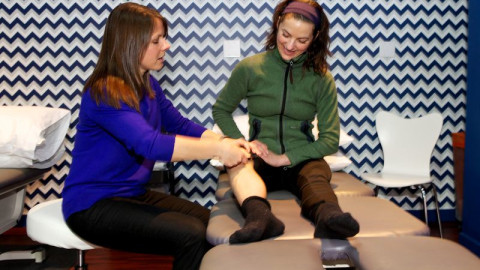Over my 10 years of working as a physical therapist and also witnessing first hand, twice, how pregnancy affects a woman’s body, I’ve come to develop a simple program to help and begin the process of retransformation post-pregnancy. This nine month alteration carries some potentially serious long-term effects if the proper steps aren’t taken. In dealing with this topic, it’s important to first discuss what happens to the body during pregnancy from a musculoskeletal perspective.
Ab Separation, Pelvic Floor Descension, Oh My!
As your baby grows, your pelvic floor muscles descend and stretch which causes them to become strained. The abdominal musculature also stretches to the point that you could sustain diastasis recti (which is a fancy term meaning that you have a large gap between your right and left abdominal muscles), a condition that affects about 80% of pregnant women. Your growing belly causes your center of gravity to push forward which tilts your pelvis and creates an extra large curvature in your lower back. To compensate for this forward push, you begin to lean backwards which ends up shutting off your gluteal (butt) muscles, taking away the most powerful muscles that aid in being upright and moving.
Though there are many more muscular and skeletal changes that occur during pregnancy, the changes mentioned above are the breeding ground for lower back pain, hip pain, knee pain and even foot pain. These impairments create the ultimate triangle of poor posture which can make postpartum strengthening much more difficult.
Getting to the Root of the “Core”
The term “core” is used frequently in today’s society but most individuals who speak of their “core” are only referring to their stomach muscles. I explain the “core” to my patients as if it were a house. The top, or roof of the house, is your diaphragm. This large muscle helps you breathe and is extremely important for your mid and upper back posture. The bottom of the core is your pelvic floor which keeps everything internally supported. This is the concrete foundation of the house. The abdominal muscles, with an emphasis on your internal obliques and transverse abdominals, are the front door of the house. The back door is a combination of your teeny tiny back stabilizer muscles (called your multifidi) and your butt muscles (glutes). In this analogy, I explain to everyone that it is extremely challenging to be safe in your home if you don’t have a solid roof over your head, a solid foundation for your house to be built on, and of course, a front and back door that is secure to prevent bugs, weather and intruders from entering.
If I Have a C-section, Do I Still Need Physical Therapy?
Many women, either by choice or medical necessity, undergo a Cesarean Section. When a C-Section is required, it can be an even more difficult process of restoration for the body to get back to where it was pre-pregnancy. To better understand this difference, let’s quickly review the three distinct layers of the abdominals:
- Rectus Abdominals: The muscles that run up and down, typically referred to as the “six pack muscles”.
- Obliques: We have two sets of these, one that moves diagonally inward towards the naval and one that moves away from the naval.
- Transverse Abdominals: The deepest and most important layer.
To retrieve your baby from the uterus during a C-section, the transverse abdominus layer is greatly disrupted. This means that in addition to the stretching that occurs during pregnancy, the abdominal muscles are also cut.
Every New Mom Needs Postpartum Physical Therapy
While you’re focused on caring for your baby, it’s also important to set aside time to take care of yourself. With postpartum physical therapy, we will help you assess how your body has changed during your pregnancy. After the evaluation—which will look at your pelvic alignment, rib alignment, breathing capacity and hip mobility—I will provide you with an individualized program tailored to your specific limitations. The program will build upon concepts of activation, stabilization and strengthening for your “core” to enhance your posture and make you feel stronger, lighter, taller and more secure. You’ll slowly witness the transformation from having an extra large lower back curve (which plops your belly forward and creates the image of still being pregnant) into someone who is standing tall and strong!
How long with this change take many people ask? The honest answer is “it depends”. It depends on the deficits, impairments and limitations you demonstrate when you walk through the door to be evaluated. The program itself is six appointments long. One appointment per week for the first four weeks followed by the last two appointments spanned over 1-2 months. Those six appointments will provide you with a solid foundation to continue to work on your deficits safely and biomechanically correctly to get you to your goal. I look forward to helping you get back to feeling your pre-baby self!
Robert Lucente, PT, DPT, OCS, COMT
Therapydia Saratoga Clinic Director









